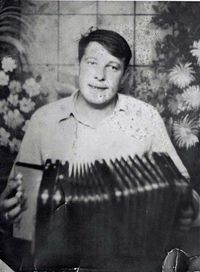Annotation:Love Bridge Waltz: Difference between revisions
No edit summary |
m (Text replacement - "garamond, serif" to "sans-serif") |
||
| (3 intermediate revisions by one other user not shown) | |||
| Line 1: | Line 1: | ||
'''Back to [[{{BASEPAGENAME}}]]''' | '''Back to [[{{BASEPAGENAME}}]]''' | ||
---- | ---- | ||
<p><font face=" | <p><font face="sans-serif" size="4"> | ||
'''LOVE BRIDGE WALTZ''' (La valse du pont d'amour). Cajun, Waltz. A Mixolydian {Doucet/Sing Out}: A Major {LeJeune/Francois}. Standard tuning (fiddle). ABCD {Doucet/Sing Out}: AA(Vocal)BAA(Vocal)BA(Vocal)BBA {Francois}. Traditional. A related song, according to Raymond Francois (1990), is Ambrose Thibodeaux's "[[Valse Independance (La)]]." The "[[Eunice Two-Step]]" is a duple-time setting of the melody. "Love Bridge Waltz" (backed with "Evangeline Special") was recorded in 1948 in Houston, Texas, by accordion player Iry LeJeune and fiddler Floyd LeBlanc. The recording was a regional hit, and helped usher in a renewed interest in Cajun music. | '''LOVE BRIDGE WALTZ''' (La valse du pont d'amour). Cajun, Waltz. A Mixolydian {Doucet/Sing Out}: A Major {LeJeune/Francois}. Standard tuning (fiddle). ABCD {Doucet/Sing Out}: AA(Vocal)BAA(Vocal)BA(Vocal)BBA {Francois}. Traditional. A related song, according to Raymond Francois (1990), is Ambrose Thibodeaux's "[[Valse Independance (La)]]." The "[[Eunice Two-Step]]" is a duple-time setting of the melody. "Love Bridge Waltz" (backed with "[[Evangeline Special]]") was recorded in 1948 in Houston, Texas, by accordion player Iry LeJeune and fiddler Floyd LeBlanc, their first single. The recording was a regional hit, and helped usher in a renewed interest in Cajun music. Lejune, the visually handicapped son of a cotton farmer, is still considered one of the best Cajun accordion players and vocalists today. | ||
[[File:Irylejeune.jpg|200px|thumb|left|Iry LeJeune]] | [[File:Irylejeune.jpg|200px|thumb|left|Iry LeJeune]] | ||
<br> | <br> | ||
<br> | <br> | ||
</font></p> | </font></p> | ||
<p><font face=" | <p><font face="sans-serif" size="4"> | ||
''Source for notated version'': Michael Doucet (La.) [Sing Out]; Iry LeJeune [http://en.wikipedia.org/wiki/Iry_LeJeune] (1928-1955, La.) [Francois]. | ''Source for notated version'': Michael Doucet (La.) [Sing Out]; Iry LeJeune [http://en.wikipedia.org/wiki/Iry_LeJeune] (1928-1955, La.) [Francois]. | ||
<br> | <br> | ||
<br> | <br> | ||
</font></p> | </font></p> | ||
<p><font face=" | <p><font face="sans-serif" size="4"> | ||
''Printed sources'': Francois ('''Yé Yaille Chère!'''), 1990; pp. 205-207. '''Sing Out''', vol. 35, No. 3, Fall 1990; p. 8. | ''Printed sources'': Francois ('''Yé Yaille Chère!'''), 1990; pp. 205-207. '''Sing Out''', vol. 35, No. 3, Fall 1990; p. 8. | ||
<br> | <br> | ||
<br> | <br> | ||
</font></p> | </font></p> | ||
<p><font face=" | <p><font face="sans-serif" size="4"> | ||
''Recorded sources'': <font color=teal>Goldband Records GB-LP7741, Iry LeJeune. Opera Records, Lejune & LeBlanc (supported by Virgil Bozeman's Oklahoma Tornadoes) (1948). </font> | ''Recorded sources'': <font color=teal>Goldband Records GB-LP7741, Iry LeJeune. Goldband Records SFC CD-713, "The Legendary Iry Lejeune." Opera Records 105A (78 RPM), Lejune & LeBlanc (supported by Virgil Bozeman's Oklahoma Tornadoes) (1948). </font> | ||
<br> | <br> | ||
<br> | <br> | ||
</font></p> | </font></p> | ||
<p><font face=" | <p><font face="sans-serif" size="4"> | ||
See also listing at:<br> | See also listing at:<br> | ||
Jane Keefer's Folk Music Index: An Index to Recorded Sources [http://www.ibiblio.org/keefer/l12.htm#Lovbrwa]<br> | Jane Keefer's Folk Music Index: An Index to Recorded Sources [http://www.ibiblio.org/keefer/l12.htm#Lovbrwa]<br> | ||
See/hear the waltz played on accordion on youtube [http://www.youtube.com/watch?v=1YfgLZaHhQw]<br> | See/hear the waltz played on accordion on youtube [http://www.youtube.com/watch?v=1YfgLZaHhQw]<br> | ||
Hear a clip from Lejeune's 1948 recording [http://www.lib.unc.edu/blogs/sfc/index.php/2010/06/24/iry-lejeune-recordings-added-to-national-recording-registry/]<br> | |||
</font></p> | </font></p> | ||
<br> | <br> | ||
Latest revision as of 15:17, 6 May 2019
Back to Love Bridge Waltz
LOVE BRIDGE WALTZ (La valse du pont d'amour). Cajun, Waltz. A Mixolydian {Doucet/Sing Out}: A Major {LeJeune/Francois}. Standard tuning (fiddle). ABCD {Doucet/Sing Out}: AA(Vocal)BAA(Vocal)BA(Vocal)BBA {Francois}. Traditional. A related song, according to Raymond Francois (1990), is Ambrose Thibodeaux's "Valse Independance (La)." The "Eunice Two-Step" is a duple-time setting of the melody. "Love Bridge Waltz" (backed with "Evangeline Special") was recorded in 1948 in Houston, Texas, by accordion player Iry LeJeune and fiddler Floyd LeBlanc, their first single. The recording was a regional hit, and helped usher in a renewed interest in Cajun music. Lejune, the visually handicapped son of a cotton farmer, is still considered one of the best Cajun accordion players and vocalists today.

Source for notated version: Michael Doucet (La.) [Sing Out]; Iry LeJeune [1] (1928-1955, La.) [Francois].
Printed sources: Francois (Yé Yaille Chère!), 1990; pp. 205-207. Sing Out, vol. 35, No. 3, Fall 1990; p. 8.
Recorded sources: Goldband Records GB-LP7741, Iry LeJeune. Goldband Records SFC CD-713, "The Legendary Iry Lejeune." Opera Records 105A (78 RPM), Lejune & LeBlanc (supported by Virgil Bozeman's Oklahoma Tornadoes) (1948).
See also listing at:
Jane Keefer's Folk Music Index: An Index to Recorded Sources [2]
See/hear the waltz played on accordion on youtube [3]
Hear a clip from Lejeune's 1948 recording [4]
Back to Love Bridge Waltz
